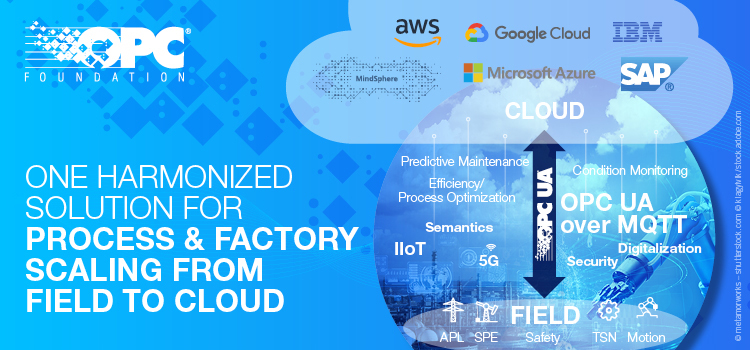Leading Internet-of-Things (IoT) vendors are adopting OPC UA technology for edge-to-cloud applications. The growing list includes Amazon Web Services (AWS), Google Cloud, IBM, Microsoft, SAP and SIEMENS.
 Key drivers behind this progression are, first and foremost, the global adoption of OPC UA as the open standard of choice for secure production-system interoperability across OT and IT networks, leveraging standardized data exchange. As such, there are over 850 registered OPC Foundation members supporting a large, rapidly growing eco-system of end-users, standards bodies, and vendors.
Key drivers behind this progression are, first and foremost, the global adoption of OPC UA as the open standard of choice for secure production-system interoperability across OT and IT networks, leveraging standardized data exchange. As such, there are over 850 registered OPC Foundation members supporting a large, rapidly growing eco-system of end-users, standards bodies, and vendors.
Second, OPC UA uses a standardized method of defining, discovering, and using Information Models (IMs) and services associated with the production systems. This standardized approach to semantic information sharing prevents vendor lock-in and costly custom programming needed for non-standard IM ingestion in the cloud. With the launch of the UA Cloud Library, OPC UA IMs are globally available to all cloud applications, making it easy for cloud applications to directly utilize OPC UA-based semantic information as well as live data coming from the edge.
Third, as a transport-agnostic, IEC standard, OPC UA is supporting two different communication patterns: Client/Server (over e.g. TCP or WebSockets) as well as Publish/Subscribe (over e.g. UDP or MQTT) to meet different industry requirements from the production systems to edge and cloud scenarios.
Fourth, the quality assurance program of the OPC Foundation extends to the OPC UA Publish/Subscribe communication patterns and forms the first multi-vendor, multi-cloud standard. Interoperability workshops, including leading PLC vendors, like Beckhoff and Siemens, sending OPC UA data from the controller, over MQTT, have already started.
Fifth, end users benefit from and eagerly welcome the commitment from major IoT vendors that support OPC UA as a standard for IoT communications.
Stefan Hoppe, President of the OPC Foundation says: “It’s thrilling to see that OPC UA is the one solution harmonized for process and factory automation, scaling from field to cloud (and back). The continued vision of the OPC Foundation – to establish OPC UA as THE open standard of choice for data interoperability throughout the world of automation – started and flourished with controllers and visualization systems and has now reached IT & the cloud. This will lead to a further growth of the open eco-system, based on OPC UA.”